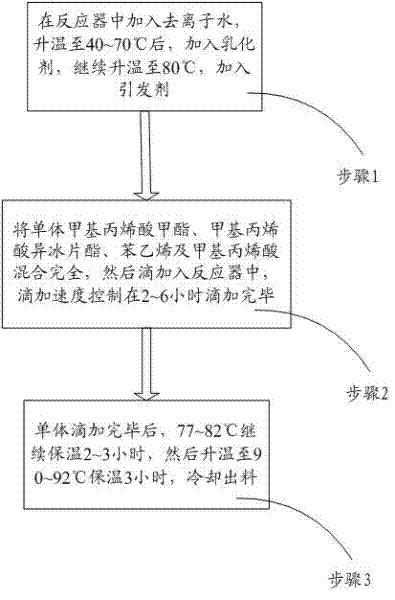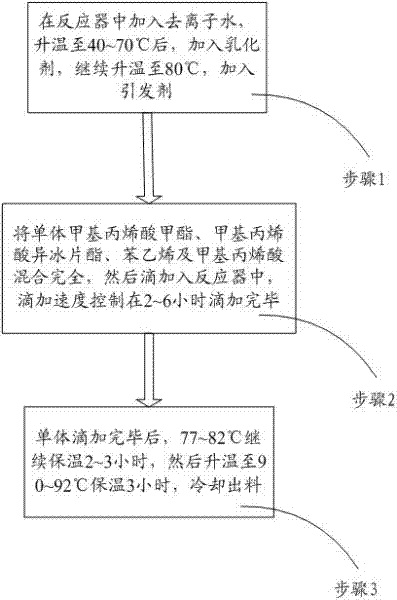Aqueous acrylic resin, and preparation method and application thereof
A technology of water-based acrylic acid and methacrylic acid, which is applied in the chemical field, can solve the problems of high production cost of polyurethane, environmental pollution, and harmfulness of solvent-based resins to the human body, and achieve cost saving, excellent physical and chemical properties, and improved moldability.
- Summary
- Abstract
- Description
- Claims
- Application Information
AI Technical Summary
Problems solved by technology
Method used
Image
Examples
preparation example Construction
[0053] The preparation method of said water-based acrylic resin is also provided in the present invention, such as figure 1 shown, including the following steps:
[0054] Step 1: Add deionized water into the reactor, heat up to 40~70°C, add emulsifier, continue to heat up to 80°C, add initiator;
[0055] Step 2: Mix the monomers methyl methacrylate, isobornyl methacrylate, styrene and methacrylic acid completely, then drop them into the reactor, and the dropping rate is controlled within 2 to 6 hours to complete the dropping;
[0056] Step 3: After the addition of the monomer is completed, keep the temperature at 77~82°C for 2~3 hours, then raise the temperature to 90~92°C for 3 hours, and then cool and discharge.
[0057] Wherein, in the step 1, the amount of deionized water added is twice the weight of the water-based acrylic resin.
[0058] The polymerization implementation method of the above formula is to use high-efficiency emulsifier EF-810 with traditional sodium dodec...
Embodiment 1
[0062] Described waterborne acrylic resin, according to weight percentage, is made up of following components:
[0063] Methyl methacrylate 50%
[0064] Styrene 20%
[0065] Isobornyl Methacrylate 23%
[0066] Methacrylic acid 4.5%
[0067] Sodium Lauryl Sulfate 1%;
[0068] EF-810 0.5%
[0069] Potassium persulfate 1%.
[0070] The preparation method of described waterborne acrylic resin is as follows:
[0071] Step 1: Add deionized water into the reactor (the amount of deionized water added is twice the weight of the water-based acrylic resin), heat up to 40°C, add an emulsifier, continue to heat up to 80°C, and add an initiator;
[0072] Step 2: Mix the monomers methyl methacrylate, isobornyl methacrylate, styrene and methacrylic acid completely, then drop them into the reactor, and the dropping rate is controlled within 3 hours to complete the dropping;
[0073] Step 3: After the addition of the monomer is completed, keep the temperature at 77°C for 2 hours, then ra...
Embodiment 2
[0082] Described waterborne acrylic resin, according to weight percentage, is made up of following components:
[0083] Methyl methacrylate 54%
[0084] Styrene 18%
[0085] Isobornyl Methacrylate 20%
[0086] Methacrylic acid 5.5%
[0087] Sodium Lauryl Sulfate 1%;
[0088] EF-810 0.5%
[0089] Potassium persulfate 1%.
[0090] The preparation method of described waterborne acrylic resin is as follows:
[0091] Step 1: Add deionized water into the reactor (the amount of deionized water added is twice the weight of the water-based acrylic resin), heat up to 55°C, add an emulsifier, continue to heat up to 80°C, and add an initiator;
[0092] Step 2: Mix the monomers methyl methacrylate, isobornyl methacrylate, styrene and methacrylic acid completely, then drop them into the reactor, and the dropping rate is controlled within 4 hours to complete the dropping;
[0093] Step 3: After the addition of the monomer is completed, keep the temperature at 82°C for 3 hours, then ra...
PUM
 Login to View More
Login to View More Abstract
Description
Claims
Application Information
 Login to View More
Login to View More - R&D
- Intellectual Property
- Life Sciences
- Materials
- Tech Scout
- Unparalleled Data Quality
- Higher Quality Content
- 60% Fewer Hallucinations
Browse by: Latest US Patents, China's latest patents, Technical Efficacy Thesaurus, Application Domain, Technology Topic, Popular Technical Reports.
© 2025 PatSnap. All rights reserved.Legal|Privacy policy|Modern Slavery Act Transparency Statement|Sitemap|About US| Contact US: help@patsnap.com


